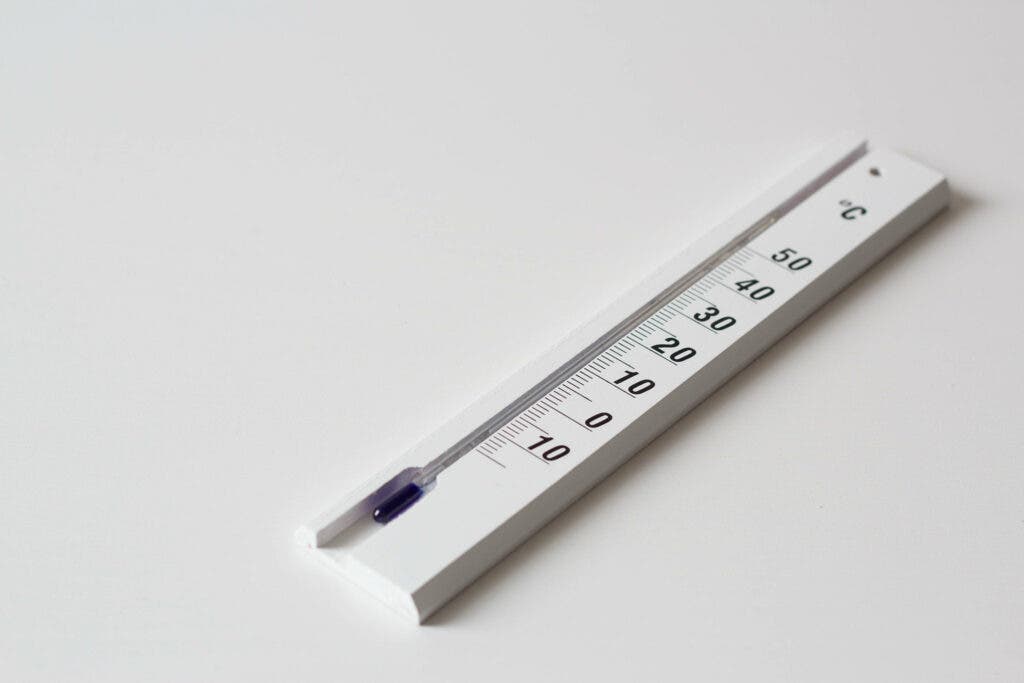Striking the perfect balance in room temperature can be a challenge, whether at home or at work. The “ideal” room temperature depends on several factors, including age, gender, activity level, and even the type of room you’re in. Room temperature is culture as much as it is physics, and this makes a one-size-fits-all solution unlikely. Let’s dive into it.

Room temperature… but what’s the room?
Room temperature typically refers to a range of temperatures considered comfortable for humans. According to the American Heritage Dictionary, it falls between 20–22 °C (68–72 °F), while the Oxford English Dictionary defines it as “about 20 °C (68 °F).” The World Health Organization (WHO) recommends maintaining at least 18 °C (64.4 °F) indoors for healthy individuals, and 20 °C (68 °F) for infants, the elderly, or those with health conditions.
Already, there’s no one clear room temperature.
What is common, however, is that in the room temperature range, a person shouldn’t be either hot or cold when wearing ordinary indoor clothing. While that sounds trivial, it’s actually quite important. The average body temperature for a human is 37ºC (98.6 °F) and our brains work hard to make sure our bodies maintain this temperature. To do this, our brain makes our body burn glucose to warm up and produce sweat to cool down. See, your brain is both wise and selfish — it knows what’s best for itself is best for the body.
Throughout different cultures, room temperature can vary quite significantly, both in the same period, and seasonally — what is considered ‘room temperature’ in the summer might not coincide with the winter room temperature.
The World Health Organization (WHO) suggests a minimum of 18 ºC (64.4 ºF) as the ideal home temperature for healthy and appropriately-dressed individuals, meaning no vest tops or shorts on indoors during winter. Meanwhile, for those very old or very young or with an illness, the WHO suggests a 20ºC (68 Fahrenheit) temperature.
The range between 18–24 ºC (64–75 ºF) isn’t associated with health risks for healthy adults with appropriate clothing, humidity and other factors, the WHO argues. In other words, anywhere within this range, you should be alright. Cold air inflames the lungs and inhibits circulation, increasing the risk of respiratory conditions
However, temperatures lower than 16 °C (61 ºF) with humidity above 65% were associated with respiratory hazards including allergies. Unfortunately, income constraints also direct what’s an acceptable room temperature. Lack of energy affordability can make it difficult for people on low incomes to heat their houses adequately. Temperatures lower than 16 °C have been linked with even worse health outcomes.
Best temperatures at home

‘Room temperature’ also depends on the room — it’s not the same whether you are in the living room, the bedroom, or the bathroom when choosing your ideal temperature.
The French Environment & Energy Management Agency (ADEME) came up with a few useful guidelines to follow depending on the room we are in. For living areas such as the living room or the dining room, ADEME suggests an ideal temperature of 19 ºC (66.2 ºF), considering it’s a place where we spend a lot of physically inactive time such as working at a desk or watching TV. This varies according to our age and health. Older people should spend their time at room temperature between 20-22ºC (68-71 ºF). Here are some recommendations:
- Living Areas: In spaces like living and dining rooms, 19 °C (66.2 °F) is ideal for sedentary activities, according to the French Environment & Energy Management Agency (ADEME). For older adults, slightly warmer temperatures of 20–22 °C (68–71 °F) are preferable.
- Bedrooms: Cooler temperatures promote better sleep, as the body’s core temperature naturally drops during rest. ADEME suggests keeping bedrooms at 16–17 °C (60.8–62.6 °F) with appropriate bedding.
- Bathrooms: To prevent discomfort after bathing, a temperature of 22 °C (71.6 °F) is recommended.
The bathroom is also a quite unique place in the house. It’s unused most of the day but we want it to be at the right temperature when we do use it. Going into a bathroom when it’s too warm or too cold can be annoying or even dangerous for your health (especially if it’s cold after you take a bath). That’s why ADEME recommends a temperature of 22ºC (71 Fahrenheit), which would be enough to feel good after we get out of the shower or the bath.
What about work?

Unsurprisingly, most people are discontent with their work temperature. A 2015 survey of office workers in the US found that 50% were dissatisfied at least several times a month with the temperature of their office. And that’s not it, as 42% said their offices were too warm during summer and 56% considered them too cold during winter — and this has many implications for organizations and their workers.
Not being able to keep workers comfortable has significant financial implications. In the UK, a study showed as much as 2% of office hours are wasted by people arguing over the temperature levels, which cost the economy $15 billion per year. Meanwhile, a study in Australia showed temperature arguments cost $6.2 billion per year. Even with all the arguments, we still have trouble finding the best room temperature.
The effects on productivity are also quite clear. A study tracked the activity of clerks in an insurance office to measure the impact of temperature on their efficiency. With a 25ºC (77 Fahrenheit) room temperature workers typed non-stop with an error rate of 10%. When the temperature dropped five degrees, they were half as productive. Even more surprisingly, the temperature in the room can influence people’s willingness to collaborate. A study showed that warmer conditions induced greater social proximity and the use of more concrete language, while another study found that holding a cup of hot coffee encouraged workers to judge others are more generous and caring.
Men vs women
There’s even a gender bias in thermal comfort, one study has found. Most office buildings set temperatures based on a decades-old formula that uses the metabolic rates of men to calculate the ideal room temperature… but this doesn’t really work for women. Women, on average, prefer room temperatures several degrees warmer than men. Because women perceive the cold more harshly than men, this lowers their ability to perform certain tasks in the office.
Study author Agne Kajackaite worked with over 500 German college students, placing them in a room and taking tests at different temperatures, ranging from 16ºC (61 Fahrenheit) to 32ºC (92 Fahrenheit). The researchers found a difference in performance between men and women depending on the temperature.
Previous studies showed women preferred rooms at 25ºC (77 Fahrenheit), while men are more comfortable at (21.6ºC). Women usually feel colder than men at the same temperature because of their physiology. Nevertheless, before Kajackaite’s work, the consequences of being colder weren’t much clear. The warmer the room, the better the women performed.
“As the temp went up, women did better on math and verbal tasks, and men did worse. And the increase for women in math and verbal tasks was much larger and more pronounced than the decrease in performance of men,” Tom Chang, co-author, said in a statement.
A matter of health
While for many healthy and young individuals, the right indoor temperature might be a matter of comfort and productivity, for the elderly it’s also a matter of health. During summer, seniors are exposed to an increased risk to their health and well-being, while in winter the risks can be as just as severe.
A study found it only takes 45 minutes for a cold room to have a significant impact on the elderly, decreasing the strength in most of the major muscle groups. With reduced strength, their safety and independence can be affected. With that in mind, the study suggested a minimum temperature of 18ºC (65 ºF).
This is also very important for babies’ health, with a recommended room temperature between 20ºC to 22ºC (68 to 72 ºF). This reduces the risk of overheating, which has been linked to fatal sleep accidents and sudden infant death syndrome (SIDS). As a general rule, if the bedroom temperature is comfortable for you, it’s also for your baby.
Ultimately, the ideal room temperature is a matter of personal preference. Some people may prefer a cooler environment, while others may prefer a warmer one. The key is to find a temperature that is comfortable for you and that allows you to achieve your goals, whether that’s getting a good night’s sleep, being productive, or reducing your energy usage.


